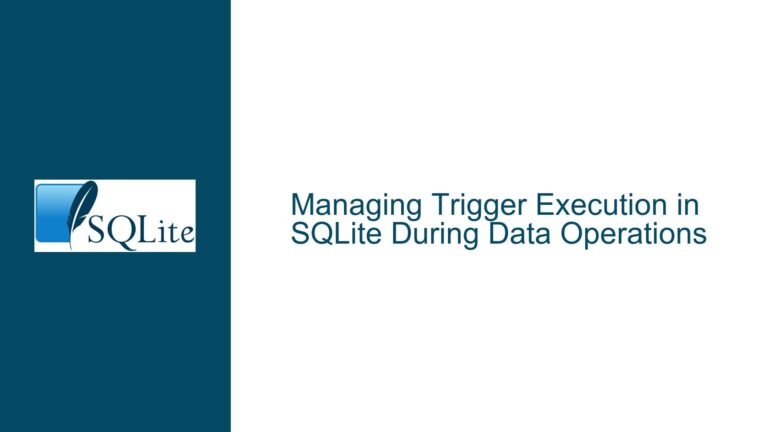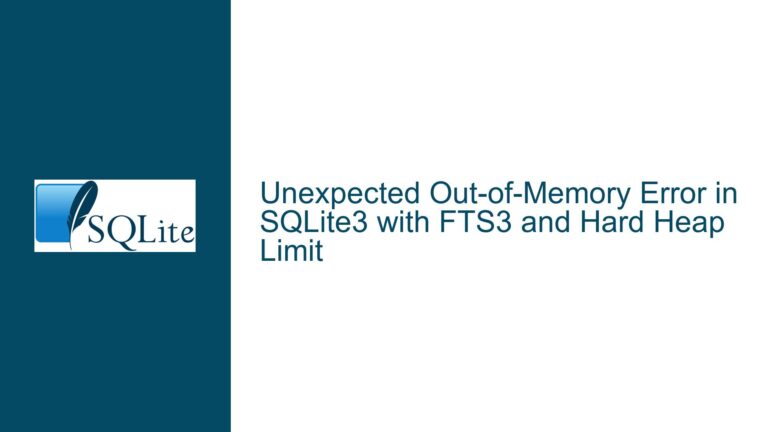SQLite Virtual Table xCommit Behavior When xBegin is Undefined
SQLite Virtual Table Transaction Commit Behavior Without xBegin
When working with SQLite virtual tables, understanding the transaction lifecycle is crucial for ensuring data integrity and consistency. A common point of confusion arises when the xCommit method is expected to be called even when the xBegin method is not defined. The xCommit method is part of the virtual table interface that handles transaction commits, but its behavior is tightly coupled with the presence of the xBegin method. If xBegin is not implemented, SQLite will not call xCommit, which can lead to unexpected behavior if the developer assumes otherwise.
The SQLite documentation states that the xCommit method is only called after a prior call to xBegin. This means that if a virtual table implementation does not provide an xBegin method, SQLite will not initiate a transaction for that virtual table, and consequently, xCommit will never be invoked. This behavior is logical from a transactional integrity perspective, as there is no transaction to commit if one was never started. However, this can be counterintuitive for developers who may not require the xBegin method but still want to handle transaction commits explicitly.
The confusion is further compounded by the fact that the xSync method, which is used to flush changes to disk, is not strictly required for the transaction lifecycle. The documentation mentions that xCommit always follows xBegin and xSync, but it does not explicitly state that xSync is optional. This can lead to misunderstandings about the necessity of implementing xSync and its relationship with xCommit.
In summary, the core issue revolves around the expectation that xCommit should be called even when xBegin is not defined. This expectation is not met because SQLite’s transaction management requires the presence of xBegin to initiate a transaction, and without it, xCommit is never invoked. This behavior is consistent with SQLite’s transactional model but may not be immediately obvious to developers, especially those who are new to working with virtual tables.
Interdependence of xBegin and xCommit in Virtual Table Transactions
The behavior of xCommit in SQLite virtual tables is intrinsically linked to the presence of the xBegin method. To understand why xCommit is not called when xBegin is undefined, it is essential to delve into the transactional model that SQLite employs for virtual tables. SQLite’s virtual table interface is designed to provide a consistent and reliable way to manage transactions, ensuring that changes to the virtual table are atomic, consistent, isolated, and durable (ACID).
The xBegin method is responsible for initiating a transaction on the virtual table. When xBegin is called, SQLite signals to the virtual table implementation that a new transaction is starting. This allows the virtual table to prepare for any changes that may occur during the transaction, such as acquiring locks or initializing internal data structures. Without xBegin, SQLite has no way of knowing that a transaction is being initiated, and thus, it cannot proceed with the subsequent steps in the transaction lifecycle.
The xCommit method, on the other hand, is called to finalize the transaction. It is responsible for committing any changes made during the transaction, ensuring that they are permanently applied to the virtual table. However, xCommit is only called if xBegin has been invoked first. This is because xCommit is part of a sequence of method calls that make up the transaction lifecycle: xBegin -> xSync -> xCommit. If xBegin is missing, this sequence is broken, and SQLite cannot proceed to call xCommit.
The interdependence of xBegin and xCommit is a deliberate design choice in SQLite. It ensures that transactions are properly managed and that the virtual table implementation is aware of the transaction boundaries. Without this interdependence, it would be possible for a virtual table to be in an inconsistent state, as it might not be prepared for the changes that occur during a transaction. By requiring xBegin to be called before xCommit, SQLite ensures that the virtual table is always in a consistent state when a transaction is committed.
However, this design choice can be problematic for developers who do not need to implement xBegin but still want to handle transaction commits. For example, a virtual table that does not require any special preparation at the start of a transaction might not need to implement xBegin. In such cases, the developer might still want to implement xCommit to perform some cleanup or finalization tasks when a transaction is committed. Unfortunately, SQLite’s current behavior does not allow for this, as xCommit will not be called unless xBegin is also implemented.
This limitation can be particularly frustrating for developers who are working with virtual tables that do not require transactional support but still need to perform some actions when a transaction is committed. In such cases, the developer is forced to implement xBegin even if it does nothing, simply to ensure that xCommit is called. This can lead to unnecessary boilerplate code and can make the virtual table implementation more complex than it needs to be.
Implementing xBegin as a No-Op to Enable xCommit Calls
Given the interdependence of xBegin and xCommit in SQLite virtual tables, the most straightforward solution to ensure that xCommit is called is to implement xBegin as a no-op (no operation). A no-op implementation of xBegin does not perform any actions but satisfies SQLite’s requirement that xBegin be called before xCommit. This allows the developer to implement xCommit without having to worry about the complexities of managing the start of a transaction.
Implementing xBegin as a no-op is a simple and effective solution that works well in most cases. However, it is important to note that this approach does have some limitations. Specifically, it assumes that the virtual table does not require any special preparation at the start of a transaction. If the virtual table does require such preparation, then xBegin should be implemented to perform the necessary actions.
To implement xBegin as a no-op, the developer simply needs to define the xBegin method and have it return SQLITE_OK. This signals to SQLite that the transaction has been successfully started, even though no actual work has been done. Once xBegin is implemented in this way, SQLite will proceed to call xSync and xCommit as part of the transaction lifecycle, allowing the developer to handle the commit as needed.
Here is an example of how to implement xBegin as a no-op in a virtual table:
static int vtabBegin(sqlite3_vtab *pVTab) {
// No-op implementation of xBegin
return SQLITE_OK;
}
With this implementation, SQLite will now call xCommit when a transaction is committed, allowing the developer to perform any necessary cleanup or finalization tasks. For example, the developer might implement xCommit to release any resources that were acquired during the transaction or to update internal data structures to reflect the changes that were made.
Here is an example of how to implement xCommit in a virtual table:
static int vtabCommit(sqlite3_vtab *pVTab) {
// Perform any necessary cleanup or finalization tasks
// For example, release resources or update internal data structures
return SQLITE_OK;
}
By implementing xBegin as a no-op and xCommit to handle the commit, the developer can ensure that the virtual table behaves correctly when transactions are committed. This approach is simple, effective, and works well in most cases where the virtual table does not require any special preparation at the start of a transaction.
However, it is important to note that this approach does not address the underlying issue of SQLite’s requirement that xBegin be called before xCommit. This requirement is a fundamental part of SQLite’s transactional model, and it is unlikely to change in the near future. As such, developers working with virtual tables should be aware of this requirement and plan accordingly.
In addition to implementing xBegin as a no-op, developers should also consider the implications of not implementing xSync. As mentioned earlier, xSync is not strictly required for the transaction lifecycle, but it is called before xCommit if it is implemented. If the virtual table does not require any special handling for syncing changes to disk, then xSync can be omitted. However, if the virtual table does require such handling, then xSync should be implemented to ensure that changes are properly flushed to disk before the transaction is committed.
Here is an example of how to implement xSync in a virtual table:
static int vtabSync(sqlite3_vtab *pVTab) {
// Perform any necessary syncing of changes to disk
return SQLITE_OK;
}
By implementing xSync in this way, the developer can ensure that changes are properly flushed to disk before the transaction is committed, further enhancing the reliability and consistency of the virtual table.
In conclusion, the behavior of xCommit in SQLite virtual tables is tightly coupled with the presence of the xBegin method. If xBegin is not implemented, SQLite will not call xCommit, which can lead to unexpected behavior for developers who assume otherwise. The most straightforward solution to this issue is to implement xBegin as a no-op, which satisfies SQLite’s requirement that xBegin be called before xCommit. This allows the developer to implement xCommit to handle transaction commits as needed, without having to worry about the complexities of managing the start of a transaction. Additionally, developers should consider the implications of not implementing xSync and implement it if necessary to ensure that changes are properly flushed to disk before the transaction is committed. By following these steps, developers can ensure that their virtual tables behave correctly and consistently when transactions are committed.






